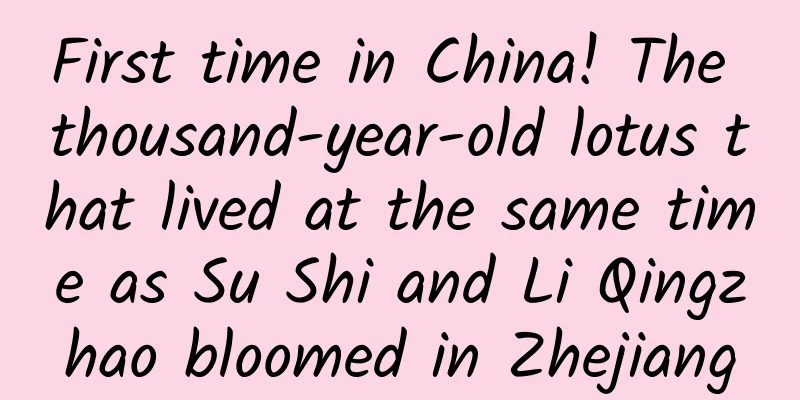First time in China! The thousand-year-old lotus that lived at the same time as Su Shi and Li Qingzhao bloomed in Zhejiang

|
On July 12, staff from the Lishui Museum posted a video online: the ancient lotus from the Song Dynasty a thousand years ago bloomed its first flower. This is also the first time that this variety of ancient lotus has bloomed in China! “I alone love the lotus that grows out of the mud but remains unstained, and washes in the clear water but remains coquettish.” "On the Love of Lotus" by Zhou Dunyi, a writer of the Northern Song Dynasty is well-known to the world. This ancient lotus seed from the Song Dynasty from Zhou Dunyi's era confirms the beauty of the ancient lotus - this lotus is hollow inside and straight outside, without vines or branches, its fragrance spreads far and wide, and it stands tall and clean, like a fairy that has spanned thousands of years of history and bloomed in the summer of 2022. Blooming ancient lotus from the Song Dynasty This flower from thousands of years ago also became a hot topic. Netizens competed to appreciate the flowers online, lamenting that they were enjoying the flowers with the "literary gods" of the Song Dynasty, such as Li Qingzhao, Wang Anshi, and Su Dongpo. Why are these ancient lotus seeds so strong? Why can they be "resurrected" after sleeping underground for hundreds or thousands of years? Ancient lotus seeds were found during the dredging of the Qinhuai River in Nanjing. Experts determined that they were unearthed from the Song Dynasty strata. On July 12, the reporter contacted Wu Donghai, a research curator at Lishui Museum, who is also an ancient lotus enthusiast. This ancient lotus from the Song Dynasty is actually the "Nanjing Ancient Lotus". It was unearthed from the Qinhuai River in Nanjing in 2017. At that time, workers were dredging the ancient river channel and found ancient lotus seeds in the silt. Experts determined that it was unearthed from the Song Dynasty strata. Four years ago, six Nanjing ancient lotus seeds were sent to Wu Donghai, and he began to plant these ancient lotuses. The newly sprouted "Nanjing Ancient Lotus" He said that the surface of the ancient lotus is very hard, so you need to use tools to file a small hole to see the flesh inside, and then soak it in water, changing the water every day. When the seeds germinate and grow small leaves, they can be transplanted into small flower pots. In fact, the first generation of seeds of Nanjing ancient lotus did not bloom, so there were no lotus seeds. Fortunately, there are two ways to breed lotus, one is lotus seeds, the other is lotus root. Every spring, take three sections of unsprouted lotus root and transplant them into a basin of water, and leaves will grow. But be careful not to make the water too deep, or the leaves will die if they cannot breathe under the water. The Nanjing ancient lotus that bloomed this time was cultivated from seed lotus roots. Some of the seed lotus roots cultivated from the first generation of Nanjing ancient lotus seeds were sent to Lishui Jiulong Wetland Park for planting, and the other part was sent to Jingning for cultivation. However, only the one in Lishui Museum has bloomed so far. Buds open Ancient lotus flowers have fewer petals than modern lotus flowers But it doesn't affect its beauty at all Wu Donghai said that he first discovered that the ancient lotus had grown a small flower bud, the color of which was a bit dark purple, but when it bloomed, it was a particularly bright pink. He knows that there are many kinds of ancient lotus seeds in China that have successfully germinated and bloomed, and they are basically named after the places where they were discovered. For example, ancient lotus was unearthed in the ruins of Kaifeng in the Northern Song Dynasty, which is called Kaifeng ancient lotus; Liangshan ancient lotus found in Liangshan, Shandong, was buried in a 6.5-meter-deep mud layer; Zhongnanhai ancient lotus was found during the dredging of Zhongnanhai in Beijing... In addition to the Nanjing ancient lotus, Wu Donghai has tried to grow five varieties of ancient lotus, including the Kaifeng ancient lotus, Liangshan ancient lotus, and Zhongnanhai ancient lotus, and has cultivated all these seeds into flowers. Ancient lotus blossoms in Nanjing Wu Donghai made careful observations from the germination of lotus seeds to the growth of leaves and then to flowering. He found that the leaves and flowers of these ancient lotus seeds were different from each other, and some were also very different from modern lotus flowers. For example, the leaves of the ancient lotus he cultivated using the second-generation seeds of the ancient lotus in Zhongnanhai in Beijing are oval; and the leaves of the thousand-year-old ancient lotus seeds in Liangshan Marsh are almost perfectly round after germination; for example, the Nanjing ancient lotus that has just opened this time has 19 petals, 4 female sepals, and 9 pistils, which is much fewer than the number of petals of modern lotus, but it does not hinder its beauty at all. Coincidentally, several "Song Dynasty ancient lotus" in the Zhejiang University Museum of Art and Archaeology also bloomed recently. These ancient lotus were unearthed from the Lao Bian River in Kaifeng. The ancient lotus blossoming was recorded in the Ming Dynasty It is like a stone, and a lotus will grow when thrown into water. The ancient lotus seeds can bloom after planting, which was recorded in the Ming Dynasty. According to the record of Beiyoulu (Volume 55) written by a Ming Dynasty writer, "There are stone lotus seeds in Ningjin County, Zhaozhou, all buried in the soil, and the age is unknown. Residents dig the soil and often find several buckets of them. They are shaped like iron stones, with fragrant flesh that does not wither. When thrown into water, they will grow lotus." Beijing Zhongnanhai Ancient Lotus Seeds In fact, since the last century, ancient lotus seeds have been discovered all over the country, many of which have successfully bloomed under artificial cultivation. Speaking of ancient lotus in China, the most famous one is the Pulandian ancient lotus. Wu Donghai said that this was the first time that ancient lotus was discovered in China in the last century. The discovery site was located in the east of Pulandian, Dalian, Liaoning Province. As early as 1923, Japanese scholars collected ancient lotus seeds in the peat layer during a geological survey in this area. Nanjing Ancient Lotus In 1953, someone dug five ancient lotus seeds from the peat in the Lianhuapao stratum in Pulandian and sent them to Professor Xu Ren of the Paleobotany Research Laboratory of the Institute of Botany, Chinese Academy of Sciences in Beijing. Miraculously, these five ancient lotus seeds germinated and blossomed in the laboratory, with two white, two pink, and one purple-red flowers, and the petals were almost indistinguishable from those of modern lotus. How can we be sure that the ancient lotus seeds are thousands of years old? According to media reports, in February 2015, a construction site in Xingkou Town, Qi County, Kaifeng City, Henan Province, unearthed "thousand-year-old lotus seeds" suspected to be from the Song Dynasty, triggering a "treasure hunt" craze among local residents. The Qi County Party Committee Propaganda Department responded that, according to preliminary judgment, these lotus seeds were naturally scattered relics, just a natural phenomenon, and no inclusions that could be used to determine the age were found in the strata at the scene, so it is impossible to determine their exact age, let alone determine that they are relics from the Song Dynasty. So, how do we determine the age of ancient lotus seeds buried deep underground? Are they thousands of years old? Wu Donghai explained that at first, due to technical limitations, scientists could only roughly estimate the lifespan of the ancient lotus. It was not until the 1950s that American scientist Li Bei published a paper on using carbon-14 to determine the age of ancient plants and carbon-containing ancient artifacts in the world. In the paper, he mentioned that he measured the age of the ancient lotus seeds in Pulandian to be a thousand years ago. Liangshan Ancient Lotus Seeds He introduced that at present, all ancient lotus varieties in China have been "aged" through this dating technology. For example, the ancient lotus he obtained from Zhongnanhai in Beijing is the youngest, and according to the stratum dating, it is between 200 and 300 years old. The ancient lotus of Liangshan in Shuibo was found to be 590 to 730 years old after carbon-14 dating by American research institutions and Xi'an Accelerator Mass Spectrometry Center. Lotus seeds grown more than a thousand years ago Why can it still sprout and bloom now? In the eyes of many people, it is incredible that lotus seeds from more than a thousand years ago can be preserved to this day. Why can they still sprout and even bloom? Wu Donghai said that it is now recognized in the industry that as long as the cultivation method is appropriate, the germination rate of ancient lotus seeds can reach more than 90%, and some are even close to 100%. The reason why lotus seeds have such amazing vitality is mainly due to their special structure. The outer layer of the lotus seed peel is particularly tough. There is a layer of strong and dense fence-like tissue under the epidermal cells of the peel. There is a stomata channel under the stomata. When the lotus seed is not yet mature, air can enter and exit freely. Once the lotus seed is fully mature, the pores will shrink or even close. Not only air and moisture cannot enter and exit, but even microorganisms are isolated from the outside. It is equivalent to making a natural "sealed warehouse" for the lotus seed embryo in the peel. For plant seeds, if the water content in the seeds does not change and the protoplasm of the seed embryo does not solidify, the vitality can be extended. Nanjing ancient lotus grows leaves Most of the ancient lotus discovered so far were found during river dredging. Ancient lotus is usually buried deep underground. If buried in the soil less than one meter underground, the temperature is lower and more stable than when exposed to the air, which is conducive to the vitality of the ancient lotus seeds. In addition, lotus seed embryos also contain some particularly rich ingredients: oxidized ascorbic acid and glutathione. When lotus seeds germinate, oxidized ascorbic acid will gradually turn into reduced ascorbic acid, which is the vitamin C we are familiar with, promoting the development of lotus seed embryos. Therefore, the ancient lotus seeds are in an anaerobic, sterile, low-temperature and geologically stable environment, so the chemical composition inside the seeds can remain stable and wait to germinate. In Wu Donghai's words, we are particularly grateful for the characteristics of ancient lotus seeds, which allow us to have the opportunity to see the lotus that the ancients saw thousands of years ago. This romance that transcends time and space is not a fantasy. Ancient lotus seeds carried on the Shenzhou VII spacecraft How are the flowers that bloom different after returning to Earth? Wu Donghai believes that some of the ancient lotus seeds unearthed in various parts of China are likely to be the ancestors of modern lotus. Some of the genetic information carried in these ancient seeds was lost in the process of inheritance and breeding from generation to generation. Over the years, scientists have never stopped their research on ancient lotus. In addition to measuring age, the genetic maps of the six ancient lotuses in China have also been mapped. If this Nanjing ancient lotus can successfully pollinate and produce lotus seeds, Wu Donghai will send the lotus seeds to a testing agency in Beijing to conduct genetic map research. The emergence of these ancient lotus seeds may preserve some unknown genetic information of existing lotus plants, providing new and valuable genetic resources for scientific research. Using these ancient lotus seeds as materials, through artificial pollination and hybridization, some excellent varieties with ancient lotus bloodlines can be bred. In 2008, the ancient lotus seeds of Pulandian from the Dalian Pulandian Ancient Lotus Research Institute were fortunate to travel in space on the Shenzhou VII spacecraft. The ancient lotus seeds that have been to space have undergone amazing changes. When ordinary ancient lotus flowers bloom, the height of the leaves is less than 2 meters, and the diameter of the lotus pod is also within 10 centimeters. However, the ancient lotus that returned from space can grow leaves that are more than 3 meters tall, and the diameter of the lotus pod is also more than 10 centimeters. Scientists have cultivated the "Flying Ancient Lotus" variety from the mutated ancient lotus, providing a very special material for my country's lotus germplasm resources. |
<<: When it comes to the critical moment, your stomach will "revolt", be careful...
>>: New research shows that Tyrannosaurus Rex may have a small "air conditioner" in its head
Recommend
Keep product operation analysis
This article is a product analysis report of Keep...
Service registration and discovery based on Zookeeper
background Most systems start with a single syste...
Sweepstakes activity gameplay planning!
The low threshold and uncertainty of lottery oper...
Dali said: A compulsory course for live broadcast products: five courses analyzing the underlying operational logic of product selection, testing, ranking, and promotion in live broadcast rooms
Dali said that live broadcast products are a must...
A complete method for running a good event, with 12 cases
Even if the product's features and experience...
The practical method of increasing 3 million followers on Douyin in 3 months
I have been working on TikTok for more than a yea...
Delphi and Mobileye collaborate to build CSLP autonomous driving platform
Delphi and Mobileye, as the industry's leadin...
What is a 400 number? What are the numbers starting with 400 for?
The 400 telephone number is a 10-digit number. It...
Electric Technology Auto News: Compared with the rise of SUVs, domestically produced sedans have stagnated. Can the Roewe i6 break the dilemma?
It is an indisputable fact that Chinese brands ar...
There is a 2000 yuan original project outside. If you make 6-8 videos per day, it is easy to earn over 100 yuan.
There is a 2000 yuan original project outside. Yo...
iOS 10 new features improve secure WiFi connection pop-up reminder
WiFi has now become a technology that people rely...
A comprehensive article on user retention!
Faced with the current situation of difficulties ...
Alipay and WeChat payment codes are restricted. What will happen to individual merchants?
Today, a piece of news swept the Internet, saying...
NDRC releases electric vehicle electricity price policy: not expensive
The National Development and Reform Commission iss...
The flame of geology is constantly burning, and the geological spirit is passed down from generation to generation - the geological life of "Volcano Academician" Liu Jiaqi
He embodies the hard-working spirit, innovative s...









